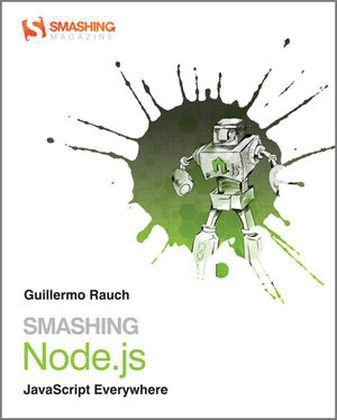
Smashing Node.js - JavaScript Everywhere
John Wiley & Sons Inc (Verlag)
978-1-119-96259-5 (ISBN)
- Titel ist leider vergriffen;
keine Neuauflage - Artikel merken
Learn to make more efficient apps, with just one language! Smashing Node.js: JavaScript Everywhere equips you with the necessary tools to understand Node.js and its uses in developing efficient web apps. With more traditional web servers becoming obsolete, having knowledge on servers that achieve high scalability and optimal resource consumption using Node.js is the key to your app development success. Teaching you the essentials to making event-driven server-side apps, this book demonstrates how you can use less space and take less time for communication between web client and server. Contains numerous hands-on examples Explains implementation of real-time apps including Socket.IO and HTML5, and WebSockets Addresses practical Node.js advantages from specific design choices Demonstrates why knowledge and use of JavaScript is beneficial Includes an interactive online component with sample chapters Explains components of stand out apps including brevity and benchmarks Looking to enhance your abilities even further? Smashing Node.js: JavaScript Everywhere makes developing server-side apps accessible with its focus on JavaScript, open source, and easy-to-use language.
Guillermo Rauch is CTO and co-founder of San Francisco-based education startup LearnBoost. He is the inventor of several renowned Node.js projects, and he has been a speaker at JSConf as well as Nod.js workshops.
PART I: GETTING STARTED: SETUP AND CONCEPTS 5 Chapter 1: The Setup 7 Installing on Windows 8 Installing on OS X 8 Installing on Linux 8 Compiling 9 Ensuring that it works 9 The Node REPL 9 Executing a file 10 NPM 10 Installing modules 11 Defining your own module 12 Installing binary utilities 13 Exploring the NPM registry 14 Summary 14 Chapter 2: JavaScript: An Overview 15 Introduction 15 Basic JavaScript 16 Types 16 Type hiccups 16 Functions 18 this, Function#call, and Function#apply 18 Functionarity 19 Closures 19 Classes 20 Inheritance 20 try {} catch {} 21 v8 JavaScript 22 Object#keys 22 Array#isArray 23 Array methods 23 String methods 24 JSON 24 Function#bind 24 Function#name 24 -proto- (inheritance) 25 Accessors 25 Summary 26 Chapter 3: Blocking and Non-blocking IO 27 With great power comes great responsibility 28 Blocking-ness 29 A single-threaded world 31 Error handling 33 Stack traces 35 Summary 37 Chapter 4: Node JavaScript 39 The global object 40 Useful globals 40 The module system 41 Absolute and relative modules 41 Exposing APIs 44 Events 45 Buffers 47 Summary 48 PART II: ESSENTIAL NODE APIS 49 Chapter 5: CLI and FS APIs: Your First Application 51 Requirements 52 Writing your first program 52 Creating the module 53 Sync or async? 54 Understanding streams 55 Input and ouput 57 Refactoring 59 Interacting with the fs 61 Exploring the CLI 63 Argv 63 Working directory 64 Environmental variables 65 Exiting 65 Signals 65 ANSI escape codes 66 Exploring the fs module 66 Streams 67 Watch 67 Summary 68 Chapter 6: TCP 69 What are the characteristics of TCP? 70 Connection-oriented communication and same-order delivery 70 Byte orientation 70 Reliability 71 Flow control 71 Congestion control 71 Telnet 71 A TCP chat program 74 Creating the module 74 Understanding the net.server API 74 Receiving connections 76 The data event 77 State and keeping track of connections 79 Wrap up 81 An IRC Client program 83 Creating the module 83 Understanding the net#Stream API 84 Implementing part of the IRC protocol 84 Testing with a real-world IRC server 85 Summary 85 Chapter 7: HTTP 87 The structure of HTTP 88 Headers 89 Connections 93 A simple web server 94 Creating the module 95 Printing out the form 95 Methods and URLs 97 Data 99 Putting the pieces together 102 Bullet-proofing 103 A Twitter web client 104 Creating the module 104 Making a simple HTTP request 104 Sending a body of data 106 Getting tweets 107 A superagent to the rescue 110 Reloading HTTP servers with up 111 Summary 112 PART III: WEB DEVELOPMENT 113 Chapter 8: Connect 115 A simple website with HTTP 116 A simple website with Connect 119 Middleware 121 Writing reusable middleware 122 Static middleware 127 Query 128 Logger 129 Body parser 131 Cookies 134 Session 134 REDIS sessions 140 methodOverride 141 basicAuth 141 Summary 144 Chapter 9: Express 145 A simple express app 146 Creating the module 146 HTML 146 Setup 147 Defining routes 148 Search 150 Run 152 Settings 153 Template engines 154 Error handling 155 Convenience methods 155 Routes 157 Middleware 159 Organization strategies 160 Summary 162 Chapter 10: WebSocket 163 AJAX 164 HTML5 WebSocket 166 An Echo Example 167 Setting it up 167 Setting up the server 168 Setting up the client 169 Running the server 170 Mouse cursors 171 Setting up the example 171 Setting up the server 172 Setting up the client 174 Running the server 176 The Challenges Ahead 177 Close doesn't mean disconnect 177 JSON 177 Reconnections 177 Broadcasting 177 WebSockets are HTML5: Older browsers don't support them 177 The solution 178 Summary 178 Chapter 11: Socket.IO 179 Transports 180 Disconnected versus closed 180 Events 180 Namespaces 181 A chat program 182 Setting up the program 182 Setting up the server 182 Setting up the client 183 Events and Broadcasting 185 Ensuring reception 190 A DJ-by-turns application 191 Extending the chat 191 Integrating with the Grooveshark API 193 Playing 196 Summary 201 PART IV: DATABASES 203 Chapter 12: MongoDB 205 Installation 207 Accessing MongoDB: A user authentication example 208 Setting up the application 208 Creating the Express app 208 Connecting to MongoDB 212 Creating documents 214 Finding documents 215 Authentication middleware 217 Validation 218 Atomicity 219 Safe mode 219 Introducing Mongoose 220 Defining a model 220 Defining nested keys 222 Defining embedded documents 222 Setting up indexes 222 Middleware 223 Inspecting the state of the model 223 Querying 224 Extending queries 224 Sorting 224 Making Selections 224 Limiting 225 Skipping 225 Populating keys automatically 225 Casting 225 A mongoose example 226 Setting up the application 226 Refactoring 226 Setting up models 227 Summary 229 Chapter 13: MySQL 231 node-mysql 232 Setting it up 232 The Express app 232 Connecting to MySQL 234 Initializing the script 234 Creating data 238 Fetching data 242 sequelize 244 Setting up sequelize 245 Setting up the Express app 245 Connecting sequelize 248 Defining models and synchronizing 249 Creating data 250 Retrieving data 253 Removing data 254 Wrapping up 256 Summary 257 Chapter 14: Redis 259 Installing Redis 261 The Redis query language 261 Data types 262 Strings 263 Hashes 263 Lists 265 Sets 265 Sorted sets 266 Redis and Node 266 Implementing a social graph with node-redis 267 Summary 276 PART V: TESTING 277 Chapter 15: Code Sharing 279 What can be shared? 280 Writing compatible JavaScript 280 Exposing modules 280 Shimming ECMA APIs 282 Shimming Node APIs 283 Shimming browser APIs 284 Cross-browser inheritance 284 Putting it all together: browserbuild 285 A basic example 286 Summary 288 Chapter 16: Testing 289 Simple testing 290 The test subject 290 The test strategy 290 The test program 291 Expect.JS 292 API overview 292 Mocha 294 Testing asynchronous code 295 BDD style 297 TDD style 298 Exports style 298 Taking Mocha to the browser 299 Summary 300
| Erscheint lt. Verlag | 4.9.2012 |
|---|---|
| Reihe/Serie | Smashing Magazine Book Series |
| Verlagsort | New York |
| Sprache | englisch |
| Maße | 1877 x 2276 mm |
| Gewicht | 1 g |
| Einbandart | Paperback |
| Themenwelt | Informatik ► Office Programme ► Outlook |
| Mathematik / Informatik ► Informatik ► Web / Internet | |
| ISBN-10 | 1-119-96259-5 / 1119962595 |
| ISBN-13 | 978-1-119-96259-5 / 9781119962595 |
| Zustand | Neuware |
| Haben Sie eine Frage zum Produkt? |
aus dem Bereich


